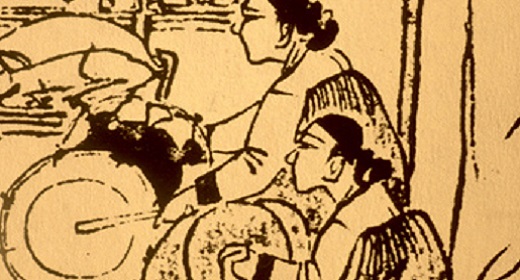by Hittendra Wahdwa: The story of the spiritual teacher who was a silent force in the life of the most important entrepreneur of our times…
Steve Jobs planned every detail of his own memorial service, held at Stanford University in October 2011, including the brown box each attendee received as a farewell gift. One of those attendees was Mark Benioff, CEO of Salesforce.com, and two years later at a TechCrunch Disrupt conference he recounted his feelings at the moment when he opened the box: “This is going to be good,” he recalled. “I knew that this was a decision [Steve] made, and whatever it was, it was the last thing he wanted us all to think about.”
The box contained the book Autobiography of a Yogi by Paramahansa Yogananda. Benioff continued: “Yogananda…had this book on self-realization…. [Steve’s] last message to us was that here is Yogananda’s book…. Actualize yourself.
“I look at Steve as a very spiritual person,” he added. “[Steve] had this incredible realization–that his intuition was his greatest gift and he needed to look at the world from the inside out.”
This inner-oriented perspective may be getting lost not only to entrepreneurs, but to modern practitioners of physical yoga too. As the world celebrates the first International Yoga Day today, it is valuable for entrepreneurs and yogis alike to step back from the unending pursuit of outer results to explore Jobs’s and Yogananda’s message of self-realization. What possibilities might freshly emerge in your search for success–in work and in life–if you too look at the world from the inside out?
Yoga, a discipline from India that is so ancient in its roots that you can credit it only to unknown truth-seekers from some glorious past era, has an outer form that has seized our collective imagination: For 30 minutes every day, disconnect from the world, take your body through an array of yoga poses, breathe deeply, keep the mind focused, and presto! You will emerge relaxed, rejuvenated, and ready again to re-engage with the relentless pace of life.
By all accounts, yoga is one of modern civilization’s great movements. In the U.S. alone, more than 20 million people today are pursuing yoga–one of every 10 adults. This yoga revival is in direct response to an increased hunger for physical and mental well-being, and a growing suspicion that there’s more to the pursuit of happiness than the material accoutrements of modern civilization. A panoply of yoga instructors have arrived to offer their own twists to ancient poses. Western inventiveness has flourished in the bountiful soil of yoga; today, some instructors are even offering doga–yoga for your dog.
Yoga’s deeper purpose: Inner transformation.
But Jobs was on a quest for something altogether more powerful than stress-reduction, toning, and fitness. He was seeking the kind of inner transformation that many practitioners sense yoga is inviting them to embark on, but don’t know where it will take them or how to get there.
For this deeper dive, you can turn to the Yoga Sutras of Patanjali, one of the authoritative and few-surviving ancient texts on yoga. Patanjali teaches that “yoga” means “union”–the dissolving of one’s individual self in the larger ocean of consciousness that pervades the universe–and that to help us achieve this union is yoga’s real purpose. Now you might think: “What is this ‘universal consciousness’ that Patanjali is talking about? And how can I ever get there?”
And that may be why Jobs, in his own quest for higher consciousness, turned to Yogananda.
Yogananda’s story is an inspiring lesson in spiritual entrepreneurship. Born in 1893 in Gorakhpur, India, he alighted on American soil at the young age of 27 with little money in his pocket but with a firm resolve to reawaken humanity to the power of yoga for inner transformation. Over the next few years he brought this message to packed audiences of thousands in all major U.S. cities, at Carnegie Hall in New York City, for example, dressing this ancient teaching in a practical modern form he called self-realization–a journey he characterized as transcending your individual self (ego) and realizing and reclaiming your true universal self (soul). As the American people were being buffeted by the thunderous wrath of two world wars and a major depression, he exhorted them to practice yoga so they could discover that the spiritual anchorage they were seeking was already with them–in fact, it was withinthem. The successful yogi, he stated, “can stand unshaken amidst the crash of breaking worlds.”
It is no wonder that many accomplished men and women of Yogananda’s era took to his teaching, including the entrepreneur George Eastman, founder of Kodak; the acclaimed opera singer Amelita Galli-Curci; the tenor Vladimir Rosing; and the plant scientist Luther Burbank. Even U.S. president Calvin Coolidge invited Yogananda to the White House for a personal audience. Today he is recognized among yoga experts as the father of yoga in the West.
Great teachers look into the vast beyond and then craft their message to speak not just to their immediate audience but to future generations as well. As early as 1920, Yogananda recognized that yoga would be a boundless fountain to quench people’s growing thirst for meaning, authenticity, and a personal experience of truth. So, with an entrepreneurial flair not typical among spiritual teachers, he laid the foundation of an institution, Self-Realization Fellowship (SRF), to ignite the inner flame of yoga in communities worldwide. He once said, “I don’t use religion for business but I use business principles in religion.” Today, there are hundreds of SRF meditation groups and centers around the world that serve tens of thousands of members. He also worked to develop living exemplars of his teachings by setting up a monastic order within SRF that now includes more than 250 monks and nuns dedicated to their own pursuit of soul-unfoldment and to serving his organization’s mission.
The journey to self-realization: Yogananda’s practical techniques.
Yogananda’s teachings don’t simply stop at the idea of universal consciousness. He correctly anticipated the growing hunger among spiritual seekers for direct personal experience of the universal consciousness that the masters of yoga, and indeed mystics of every religious tradition, describe. He therefore synthesized a set of powerful but practical techniques to guide truth-seekers on the spiritual path all the way to the ultimate union, drawing on the eight steps laid out by Patanjali in the Yoga Sutras.
The modern conception of yoga–with its emphasis on outer transformation–is based on the third of Patanjali’s eight steps, “asana.” Asana emphasizes physical fitness for the purpose of getting the body ready for the stillness that is required for the inner journey taken in the subsequent steps. But prior even to asana are Patanjali’s first two steps of “yama” and “niyama”–principles to guide one’s everyday conduct and to prepare oneself for inner realization. Yoga emphasizes the importance of self-discipline as a foundation for harmonious physical, mental, and spiritual development.
Yogananda’s particular genius was showing the modern applicability of these ancient principles, attuning himself to an audience who aspired as much to outer success as inner growth by delivering talks on topics like “The Science of Healing” and “The Art of Getting What You Want.” In that regard, he was a forerunner to 21st-century psychologists, physicians, psychotherapists, and neuroscientists who are generating powerful scientific findings on human nature and well-being–all aligned with Yogananda’s teachings on consciousness, thoughts, emotions, habits, and brain wiring.
Patanjali’s final five steps beyond asana relate to a progressive deepening of the seeker’s journey toward realization of the universal self, with meditation providing the pathway. However, Patanjali’s text on these final five steps is agonizingly cryptic, with no guidance on how to execute them. To fill this void, Yogananda, ever the spiritual innovator, introduced the West to an advanced but long-lost ancient technique of meditation, Kriya Yoga. Kriya, he said, offered the ultimate journey of inner transformation, helping practitioners tap into an ever-expanding love and ever-deepening joy that would spring from within. That, he asserted, was man’s true nature–a perfection that represents our permanent state of self within, even as it is so elusive to capture without.
Kriya “works like mathematics,” he stated, emphasizing the empirical, scientific nature of this technique. Through regular practice, he claimed, Kriya will change the neural pathways in the brain. Really, you might wonder? Can the act of mindful focusing and of interiorizing our consciousness actually bring about physical changes in the brain? Very few scientists at Yogananda’s time were comfortable with his claims. Yet today revolutionary new findings in neuroscience are showing that meditation does in fact bring favorable changes in the neural pathways of the brain. Scientific laboratories are now stumbling into truths experienced by yogis across the ages in, as Yogananda would say, the inner laboratories of their personal experience.
And what would be the markers that people could look for to assess their inner progress? Lower stress? Greater peace? He had begun his own quest for self-realization very early in life, a story vibrantly captured in the critically acclaimed 2014 documentary Awake: The Life of Yogananda. His youthful search culminated in his master Sri Yukteswar giving him the monastic name “Yogananda,” which means “bliss through yoga.” True to his name, he exhorted truth-seekers to savor the early rewards of peace and well-being, but to then seek out the ultimate prize: eternal bliss, universal consciousness. “When by constant practice of Kriya, the consciousness of [the] blissful state of the spiritual self becomes real, we find ourselves always in the holy presence of the blissful God in us.” God, to Yogananda, was thus not an external force to be idolized and appropriated by any particular religion, but an inner force to be awakened to and realized.
To some, the yogic pursuit of inner perfection may appear a little selfish. What about solving the world’s most vexing problems, rather than withdrawing in blissful inner communion? In fact, one time, when Yogananda sat still, absorbed in a particularly blissful state of consciousness, his spiritual master admonished him: “You must not get overdrunk with ecstasy. Much work yet remains for you in the world.” So Yogananda learned that this choice between outer service and inner joy represents a false dichotomy. The yoga he taught emphasizes balancing service with meditation, and highlights the expansion of consciousness that comes when we are able to go beyond our human self and open ourselves up, through inner realization, to a deeper connection with every living being–in fact, with every atom in the universe. “When the ‘I’ shall die, then shall I know who am I,” he stated.
How Steve Jobs approached success from the inside out.
Yogananda’s teaching of universal consciousness strongly appealed to Steve Jobs, who had a self-professed hunger to “make a dent in the universe.” At the TechCrunch conference in September 2013, Mark Benioff said: “[Yogananda’s book] gives tremendous insight into not just who [Jobs] was but also why he was successful, which is that he was not afraid to take that key journey [toward self-realization]. It is for entrepreneurs and for people who want to be successful in our industry a message that we need to embrace and vest ourselves in.”
Since Yogananda’s passing in 1952, many teachers have followed his trailblazing path to bring yoga to our world, helping make it a fixture in popular culture as it continues to take hold with young and old, the elite and the ordinary, the spiritualists and the atheists. What distinguishes Yogananda from these subsequent emissaries is not simply that he paved the way for the modern yoga movement, but that from the outset he focused far beyond physical exercises and shone a powerful and practical torchlight on the path to yoga’s true purpose: actualizing the infinite potentials within us all. Perhaps that is why his Autobiography of a Yogi was the only book Jobs downloaded on his iPad–and, after first encountering the book as a teenager, went back and reread once every year.
On this first International Yoga Day, let’s tip our hats to the teacher who first introduced the modern world to the transformative power of yoga as a timeless inner discipline, and who was such a silent force in the life of the greatest entrepreneur of our times. As you roll out your yoga mat, get into your favorite yoga pose, and feel a gentle zephyr of peace sweep over you, perhaps you can take pause to wonder at what experiences in consciousness may lie just beyond your present reach if you also embark on yoga’s fuller, inner journey toward self-realization. Yogananda would have called those experiences “undreamed of possibilities.”
And as you get closer to realizing your true self within, you may find that you, too, are ready to make a dent in the universe.










































